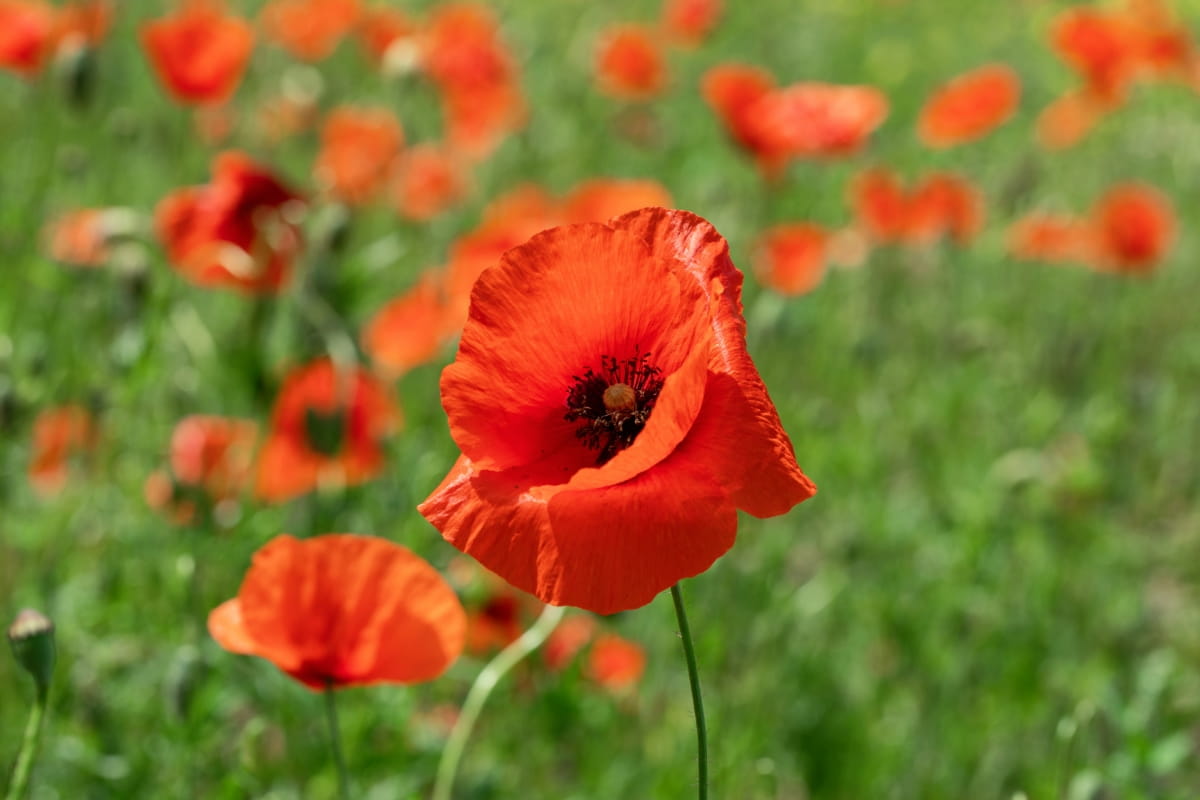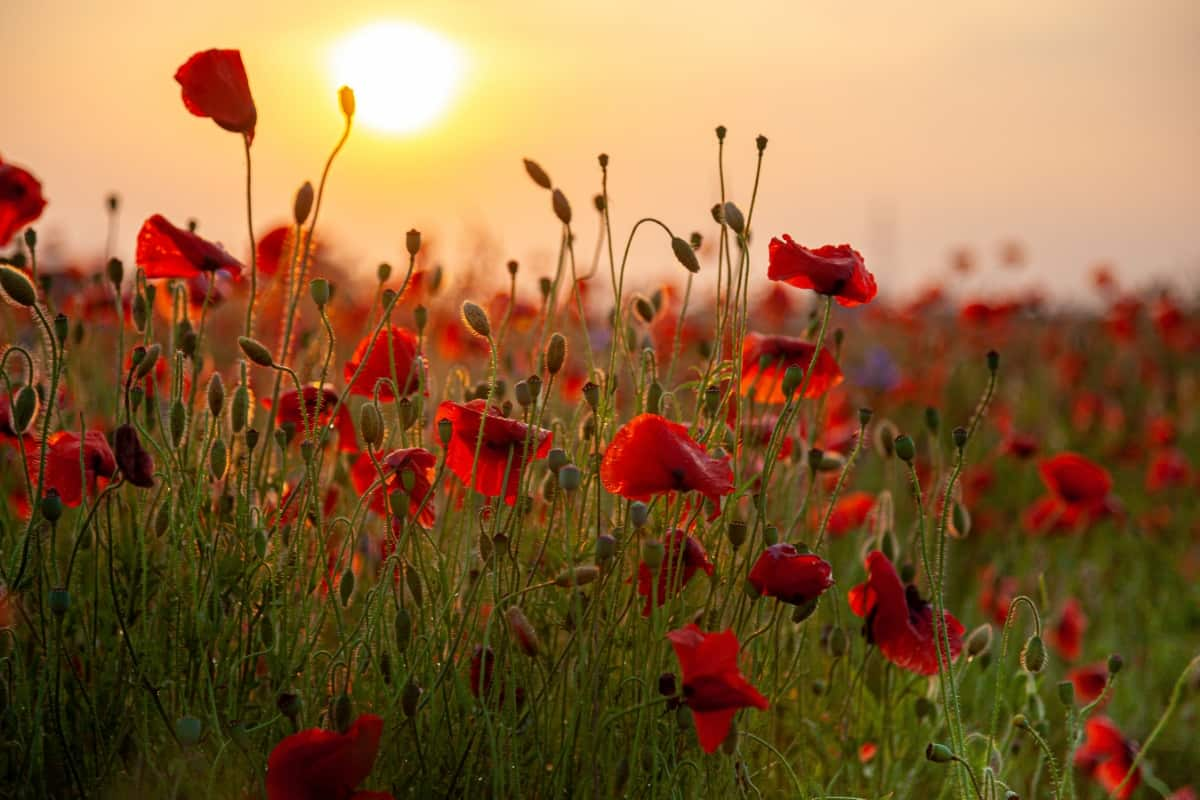The poppy flower is one of the most popular plants that gardeners of all levels can grow. Wildflowers like these are hardy, vibrant, and great at attracting pollinators like bees and butterflies because of their hardiness and vibrant colors. It is also very important to note that most poppies will self-seed, which means they will grow back naturally in your garden year after year. Here are some instructions on how to plant and care for poppy flowers.

How to Grow and Care for Poppy Flowers
Best Soil Conditions for Growing Poppy Flowers
Poppy flowers grow best in loamy soil, meaning they balance sand, silt, and clay well. Loamy soil is rich in nutrients but allows for good drainage and aeration. Poppy flowers prefer slightly acidic soil to neutral, with a pH between 6.0 and 7.0. If the soil is too acidic or alkaline, it affects the absorption of nutrients by the plant. The soil should also be rich in organic matter and nutrients like nitrogen, phosphorus, and potassium. It is recommended to add compost or well-rotted manure to the soil before planting.
Watering Tips for Poppy Flower Cultivation
- Poppy plants may rot, leading to death in soaked soils, so only water them when the soil feels dry.
- Watering the plants more than once a week is generally unnecessary.
- In hot weather or if the poppies turn brown, increase the water per water session.
- It is best not to water plants in the early afternoon, especially during sunny weather. The heated water can burn the leaves, as well as for it to evaporate before soaking into the leaves.
- Poppies need frequent watering when they germinate, but this can be reduced once they grow.
Sunlight Requirements for Healthy Poppy Flowers
Poppies require full sun exposure to grow and thrive. This means they need at least 6 hours of direct sunlight daily. They may become weak and leggy and produce fewer flowers if they don’t receive enough sunlight. In addition to the amount of sunlight, the intensity is also important. Poppies prefer bright, direct sunlight but can also tolerate some shade. However, if they receive too much shade, they may also not flower.
Pruning Techniques for Promoting Poppy Flower Growth
When flowers die back and begin to lose their petals, cut the stem back to the plant’s basal leaves or main stem. By cutting back the whole flower stem, more buds are produced while the plant looks its best.
- Remove spent foliage and stems: When the Poppies prepare for dormancy, clean up the dead and dying stems and foliage to prevent pests and diseases from spreading. Perennials with later blooms can also benefit from this.
- Final cleanup of all dead Poppy stems after it is dormant in the late summer: Cover perennial Poppies with mulch or mark their locations so fall cleanup does not disturb them.
Fertilization Schedule for Poppy Flower Care
- There is no need for extra nutrients for poppy flowers to grow and bloom. However, adding compost or manure before planting can improve the health of stems and foliage during the growing season.
- If compost or manure is unavailable, a slow-release fertilizer containing balanced Nitrogen, Phosphorus, and Potassium ratios (ex. 14-14-14) can be incorporated into the soil before planting to provide consistent nutrients.
- When using a liquid fertilizer, poppies only need one application of a high-phosphorus fertilizer from June to August to encourage strong and healthy flowering.
In case you missed it: Step-By-Step Guide on How to Grow and Care for Iris Plants

Preventing Pests and Diseases in Poppy Flowers
- Using natural remedies such as garlic or essential oils, you can treat aphid-infested plants with an insecticide such as neem oil, insecticidal soap, or a homemade remedy such as neem oil. An intense spray from the garden hose may dislodge mild infestations and cure them.
- Thrips suck plant sap and attack flowers, leaves, and stems. Leaf surfaces may be stippled, flecked, or silvered with discoloration or silvering. Many diseases can be spread from plant to plant by thrips. Thrips spread between rows of plants may be repelled by aluminum foil sheets.
- Powdery mildew can be controlled and eliminated with fungicides such as potassium bicarbonate.
- Gray mold, also known as botrytis, is a fungal disease that appears as a grayish-brown mold on the flowers and stems and can cause the flowers to rot. The disease can be prevented by removing infected flowers and providing proper air circulation around the plant.
Overwintering Strategies for Perennial Poppy Flowers
- Covering the soil around the plant’s base with mulch can insulate the roots and protect them from frost. Use a 2-3 inch layer of straw, leaves, or other organic material.
- After the first frost, cut back the plant’s foliage to about 2-3 inches above the soil line. This helps the plant conserve energy and focus on growing new foliage in the spring.
- If your area experiences harsh winters with extreme cold or heavy snow, consider covering your perennial poppies with burlap or frost blankets. This will provide an extra insulation layer and protect the plant from damage.
Companion Planting with Poppies for Improved Growth
- Marigolds are also great companions for poppies. Marigolds are known to repel pests and attract beneficial insects, making them a perfect match for poppies.
- Chamomile is a natural insect repellent and also attracts beneficial insects. Additionally, chamomile has a shallow root system that complements the deep roots of poppies, allowing the two plants to coexist without competing for nutrients.
- Lavender is an excellent companion plant for poppies because it repels pests and attracts beneficial insects. Plus, the fragrance of the lavender adds a lovely scent to your garden.
Tips for Propagating Poppy Flowers from Seed or Cuttings
- Winter or fall is the best time to sow seeds. Plants sown in the spring may not flower until the following year if they germinate. It is safe to plant Iceland poppies in the spring.
- Plants prefer loamy, rich, well-draining soil. You can loosen clay soil in full sun by adding well-rotted compost or add water retention to sandy soil by adding well-rotted compost.
- The seeds should be sprinkled over the prepared soil and pressed into the soil with the dry palm of your hand. The seeds need light to germinate, so you shouldn’t bury them more than an eighth of an inch deep.
- Sow seeds with sand mixed with them before sowing to avoid overseeding.
- Rather than water the soil from a hose, mist it instead. That way, the seeds won’t be disturbed. When the seeds have germinated, do not use a stream of water.
- Covering the planting area with chicken wire or some other protection might be necessary to keep birds from eating all the seeds.
- A surprise frost will not damage the leaves and stems once the seeds germinate, which will happen in early spring. The plants are hardy and can withstand freezing temperatures.
- If you have chosen a species or cultivar, thin the seedlings appropriately. Avoid skipping this step if you want your seedlings to produce large, showy blossoms.
Harvesting and Collecting Poppy Seeds
- seeds are ready to be harvested when the pods have dried and turned brown. This usually happens in late summer or early fall.
- Use sharp garden shears to cut the pods off the plant. Try to cut them as close to the base as possible.
- To dry out completely, place the pods in a dry, warm, and well-ventilated area. This can take up to two weeks.
- Once the pods are completely dry, use your fingers to gently crush them and release the seeds. You can also use a rolling pin or a sieve to help. Collect the seeds in a bowl or container.
- Poppy seeds can go rancid quickly, so storing them properly is important. Keep them in an airtight container in a cool, dark place. They should last for up to six months.
In case you missed it: Greenhouse Sweet Potato: How to Plant, Grow, and Care

Conclusion
Poppies are one of the most eye-catching and easy-to-care-for flowers in your garden. The poppy flower will surely brighten your days with its rich and colorful blooms. If you want to welcome spring with a sweet welcome, consider planting poppies in your garden.
- Feed Your Flock for Less: Top 10 Tips to Save on Chicken Feed
- Ultimate Guide to Ossabaw Island Hog: Breeding, Raising, Diet, and Care
- Hatching Answers: The Top 10 Reasons Your Chickens Aren’t Laying Eggs
- Eggs and Economics: Breaking Down the Cost of Raising Backyard Chickens
- Defend Your Greens: Proven Methods to Keep Iguanas Out of Your Garden
- Ultimate Guide to Cinnamon Queen Chicken: A Comprehensive Guide for Beginners
- Ultimate Guide to California Tan Chicken: Breeding, Raising, Diet, Egg-Production and Care
- Ultimate Guide to Marsh Daisy Chicken: Breeding, Raising, Diet, and Care
- 10 Types of Chicken Farming Businesses You Can Start for Profits